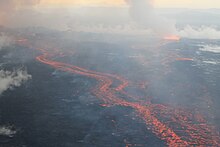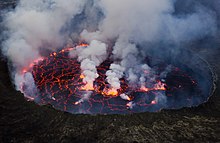Active volcano


An active volcano is a volcano which is either erupting or is likely to erupt in the future. An active volcano which is not currently erupting is known as a dormant volcano.
Overview[]
There is no consensus among volcanologists on how to define an "active" volcano. The lifespan of a volcano can vary from months to several million years, making such a distinction sometimes meaningless when compared to the lifespans of humans or even civilizations. For example, many of Earth's volcanoes have erupted dozens of times in the past few thousand years but are not currently showing signs of eruption. Given the long lifespan of such volcanoes, they are very active. By human lifespans, however, they are not.
Scientists usually consider a volcano to be erupting or likely to erupt if it is currently erupting, or showing signs of unrest such as unusual earthquake activity or significant new gas emissions. Most scientists consider a volcano active if it has erupted in the last 10,000 years (Holocene times)—the Smithsonian Global Volcanism Program uses this definition of active. As of March 2021, the Program recognizes 1,413 active volcanoes that have had eruptions during the Holocene Epoch.[1] Most volcanoes are situated on the Pacific Ring of Fire.[2] An estimated 500 million people live near active volcanoes.[2]
Historical time (or recorded history) is another timeframe for active.[3][4] However, the span of recorded history differs from region to region. In China and the Mediterranean, it reaches back nearly 3,000 years, but in the Pacific Northwest of the United States and Canada, it reaches back less than 300 years, and in Hawaii and New Zealand, only around 200 years.[3] The incomplete Catalogue of the Active Volcanoes of the World, published in parts between 1951 and 1975 by the International Association of Volcanology, uses this definition, by which there are more than 500 active volcanoes.[3][5] As of March 2021, the Smithsonian Global Volcanism Program recognizes 560 volcanoes with confirmed historical eruptions.[1]
As of 2013, the following are considered Earth's most active volcanoes:[6]
- Kīlauea, the famous Hawaiian volcano, was in nearly continuous, effusive eruption (in which lava steadily flows onto the ground) between 1983 through 2018, and had the longest-observed lava lake.
- Mount Etna and nearby Stromboli, two Mediterranean volcanoes in "almost continuous eruption"[vague] since antiquity.[clarification needed]
- Piton de la Fournaise, in Réunion, erupts frequently enough to be a tourist attraction.
As of 2010, the longest ongoing (but not necessarily continuous) volcanic eruptive phases are:[7]
- Mount Yasur, 111 years
- Mount Etna, 109 years
- Stromboli, 108 years
- Santa María, 101 years
- Sangay, 94 years
Other very active volcanoes include:
- Mount Nyiragongo and its neighbor, Nyamuragira, are Africa's most active volcanoes.
 Nyiragongo's lava lake
Nyiragongo's lava lake - Erta Ale, in the Afar Triangle, has maintained a lava lake since at least 1906.
- Mount Erebus, in Antarctica, has maintained a lava lake since at least 1972.
- Mount Merapi
- Whakaari / White Island, has been in a continuous state of releasing volcanic gas since before European observation in 1769.
- Ol Doinyo Lengai
- Ambrym
- Arenal Volcano
- Pacaya
- Klyuchevskaya Sopka
- Sheveluch
References[]
- ^ Jump up to: a b Venzke, E., ed. (2013). "How many active volcanoes are there?". Global Volcanism Program Volcanoes of the World (version 4.9.4). Smithsonian Institution. Retrieved 2 April 2021.
- ^ Jump up to: a b "Volcanoes". European Space Agency. 2009. Retrieved August 16, 2012.
- ^ Jump up to: a b c Decker, Robert Wayne; Decker, Barbara (1991). Mountains of Fire: The Nature of Volcanoes. Cambridge University Press. p. 7. ISBN 978-0-521-31290-5.
- ^ Tilling, Robert I. (1997). "Volcano environments". Volcanoes. Denver, Colorado: U.S. Department of the Interior, U.S. Geological Survey. Retrieved August 16, 2012.
There are more than 500 active volcanoes (those that have erupted at least once within recorded history) in the world
- ^ DeFelice, B.; Spydell, D.R.; Stoiber, R.E. (14 November 1997). "Catalogs of Active Volcanoes". The Electronic Volcano. Dartmouth College. Archived from the original on 2020-01-19. Retrieved 16 April 2021.
- ^ "The most active volcanoes in the world". VolcanoDiscovery.com. Retrieved August 3, 2013.
- ^ Leontiou, A. (2 November 2010). "The World's Five Most Active Volcanoes". livescience.com. Retrieved August 4, 2013.
See also[]
- Category:Active volcanoes
- Category:Potentially active volcanoes
- List of currently erupting volcanoes
- Active volcanoes
